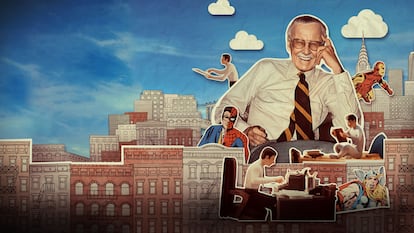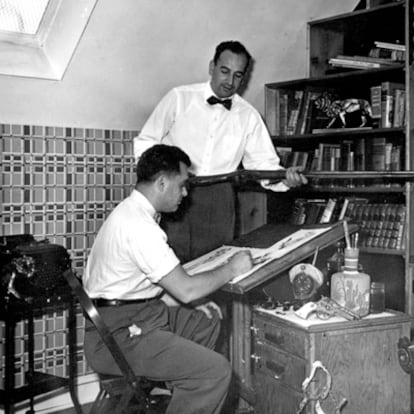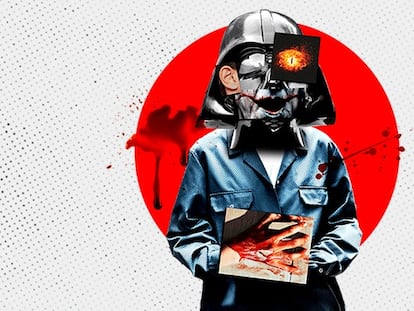Stan Lee: The fantastic one
A documentary about the legendary Marvel scriptwriter and editor reinforces the disputed legend that he single-handedly invented icons such as Spiderman and the Hulk, and undervalues the creative work of Jack Kirby and Steve Ditko

In his first job, they didn’t even call him by his first name. Basically, because nobody knew it. He was the guy who brought coffees and ran back and forth. When that young clerk was laid off, few in the trouser factory would remember him. But from then on, however, he was never again anonymous. It was all about a well-chosen pseudonym. And, above all, of an overflowing talent. Because Stanley Martin Lieber, or as we now know him, Stan Lee, forever changed the history of comics and popular culture. Deserving of multiple biographies, the legend is for the most part, however, questionable and contested. So is a new documentary, by David Gelb, available on Disney + just as Lee would have turned 100 years old.
Myth, according to Merriam-Webster’s dictionary, is defined as: “a popular belief or tradition that has grown up around something or someone.” It goes for the idols Lee (co-)created, from the Hulk to Spiderman. But it has ended up applying to the writer and editor’s own story as well. The title of his comic book biography, Amazing, Fantastic, Incredible: A Marvelous Memoir (Simon & Schuster), summarizes the mythic status that Lee’s figure has usually received, fed by himself. And that, except for some opportune nuances, Gelb’s film reiterates, dedicated to reconstructing (in chronological order) the author’s meteoric rise. In a statement, Neal Kirby, the son of Jack, cartoonist and co-creator of many Marvel icons, has already lamented the umpteenth version of the story according to which Lee did everything and his father did hardly anything.
My father Neal Kirby (Jack Kirby’s son) has asked me to post this written statement in response to the Stan Lee documentary released yesterday on Disney+. pic.twitter.com/V4be2xyEJg
— Jillian Kirby (Granddaughter of Jack Kirby) (@Kirby4Heroes) June 17, 2023
It is likely that the most repeated word in the film — which mixes old interviews, archive images and original reconstructions through models and dolls — is “I.” Neal Kirby, in fact, challenges you to count them. They increase, above all, when telling the story of the most controversial issue: the origin of Marvel’s main symbols, which then started a revolution and still mean millions of dollars and followers today. By now, the controversy is well known: Lee always maintained that he had the ideas and the cartoonists contributed to putting them into practice. And everyone attributes him with the key events in the lives of more human and fragile superheroes, who lived in the real world and met from time to time. However, Kirby and (in the case of Spiderman) Steve Ditko claimed a seminal role in the creation process. And they fought for decades to see it recognized.
At least in part, that controversy is reflected in the feature film. We hear how a friendly radio reunion between Lee and Kirby in 1987 becomes tense as soon as old disputes arise. The screenwriter and editor considers the original spark was always his, although he acknowledges that the pace of publication, which success made hellishly fast — up to two comics a day — forced him to make a change: from writing “story after story” to delivering a rough plot, which the cartoonist would recreate as he wished, for Lee to then add the dialogue. “It could come back to me with the same plot, or with a bunch of changes,” he notes. And he says how that patch became routine. So much so that it became known as the Marvel Method: it allowed artists to shine more brightly, but did not recognize them in terms of rights and money. Even today, many cartoonists still accuse the company of underpayments, abusive contracts and undervaluation.
Finally, through the fight between Lee and Ditko over the paternity of Spiderman, the documentary raises a debate: the writer says that he who creates brings the original idea; the artist argues that developing and bringing it to life on the page it is part of the invention. Neal Kirby, in his communiqué, makes his opinion clear with a more or less appropriate example: is Michelangelo not considered the creator of the statue of Moses, commissioned and designed by the pope, since it was he who shaped it and breathed a soul into it?
It is true that the documentary entitled Stan Lee is told through his voice and from his perspective, with all that that entails. But it is especially debatable that Disney, owner of Marvel and therefore the main defendant and presumed judge in the dispute, would choose to shine a light on one side. And, consequently, overshadow the other. Nor does it benefit Marvel’s image to take sides by once again undervaluing cartoonists. This is not to demand the (perhaps overly) critical spirit of journalist Abraham Riesman, who writes at True Believer: The Rise and Fall of Stan Lee (Crown): “His story is the place where objective truth goes to die.” But at least the “superhuman contradictions,” highlighted in A Marvelous Life: The Amazing Story of Stan Lee, by Danny Fingeroth (St. Martin’s Press), former Marvel scriptwriter and editor. In short, to take the matter seriously. It would be, in essence, a sign of respect for the legend himself.

Sign up for our weekly newsletter to get more English-language news coverage from EL PAÍS USA Edition
Tu suscripción se está usando en otro dispositivo
¿Quieres añadir otro usuario a tu suscripción?
Si continúas leyendo en este dispositivo, no se podrá leer en el otro.
FlechaTu suscripción se está usando en otro dispositivo y solo puedes acceder a EL PAÍS desde un dispositivo a la vez.
Si quieres compartir tu cuenta, cambia tu suscripción a la modalidad Premium, así podrás añadir otro usuario. Cada uno accederá con su propia cuenta de email, lo que os permitirá personalizar vuestra experiencia en EL PAÍS.
¿Tienes una suscripción de empresa? Accede aquí para contratar más cuentas.
En el caso de no saber quién está usando tu cuenta, te recomendamos cambiar tu contraseña aquí.
Si decides continuar compartiendo tu cuenta, este mensaje se mostrará en tu dispositivo y en el de la otra persona que está usando tu cuenta de forma indefinida, afectando a tu experiencia de lectura. Puedes consultar aquí los términos y condiciones de la suscripción digital.











































